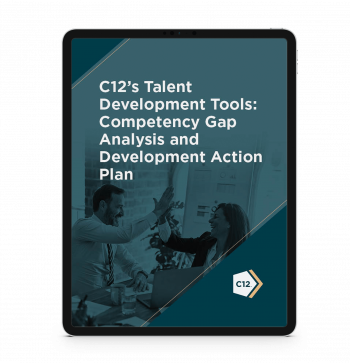Staff to C-Suite: How to Identify and Develop Executive Talent in Your Company – Part Two
Developing a Leadership Pipeline in Your Business
In today’s hyper-competitive hiring landscape, executive talent is in high demand. Every day, 10,000 baby boomers reach retirement age, leaving a leadership vacuum in many companies. While hiring external talent has been the traditional method for filling executive positions, it has become increasingly costly and risky. Companies are often forced to spend six figures to obtain an executive-level candidate, and even so, executive searches fail 40% of the time. Without a strong leadership pipeline, critical roles can be left unfilled—sometimes for months or even years.
Executive talent development is the process of identifying, cultivating, and preparing individuals for leadership roles. In part one of our two-part series, “Staff to C-Suite: How to Identify and Develop Executive Talent in Your Company,” we explored how to identify people with leadership potential in your workforce. In this article, we will explore how to develop these high-potential employees so they will be ready and able to assume leadership roles in the future.
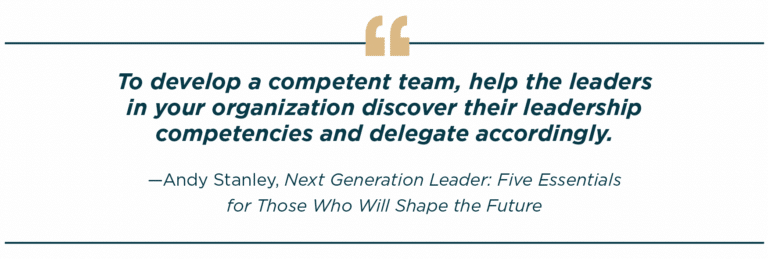
When you invest in developing executive talent, you build a leadership pipeline that benefits both your organization and the talent within your organization. A well-executed development strategy will ensure that future leaders possess both cultural fit and executive readiness. By mentoring high-potential employees, who have already shown competence and cultural alignment, companies can customize a training pathway to develop the specific executive requirements the business needs. With the right experience under their belts, these leaders can seamlessly transition into executive roles.
A strong leadership pipeline can also serve as a retention magnet to keep talented employees in your company. A recent global study revealed that nearly half of employees would consider leaving an organization if their employers neglected their skill development or failed to offer growth opportunities.
How Does Executive Talent Development Differ from Professional Training?
Executive talent development is a specialized aspect of a company’s training efforts, distinct from general workplace training in significant ways. While typical training programs emphasize the acquisition of “hard skills” that are necessary for specific tasks or job functions, executive talent development prioritizes the development of “soft skills” that are essential for individuals with leadership potential to advance into leadership positions.
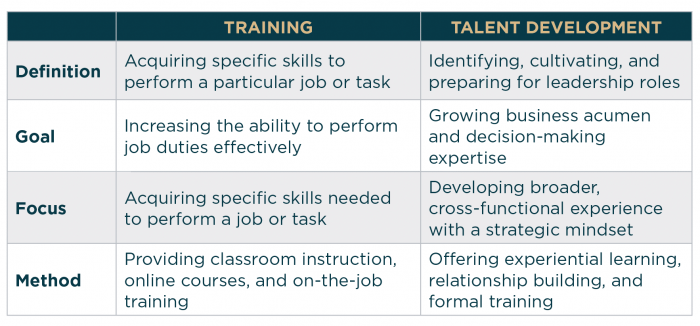
The distinction between training and executive talent development becomes apparent when examining their learning methodologies. General training often relies on classroom-based instruction and hands-on learning experiences within the job environment. In contrast, executive talent development places a greater emphasis on experiential learning opportunities and mentorship programs that are tailored to the unique needs of future leaders.
How Do You Determine the Competencies Needed for Executive Talent?
To effectively develop your high-potential employees into future leaders, it is crucial to recognize that while they may have achieved success in their current positions, they could still lack the essential skills needed for higher levels of leadership. Conducting a competency gap analysis serves as a crucial first step in this process. A competency gap analysis enables you to identify both the strengths and areas for improvement in your high-potential employees across three areas:
- Self-leadership skills
- Interpersonal leadership skills
- Organizational leadership skills
Typically, younger leaders will demonstrate strong self-leadership skills but may require experience and training in interpersonal and organizational leadership. Through a competency gap analysis, you can identify these areas for growth and provide targeted guidance to facilitate their improvement.
Download C12’s Competency Gap Analysis to evaluate the developmental needs of your high-potential employees and chart a path for their advancement within your organization.
How Do You Develop Executive Talent?
Once you have identified employees with leadership potential and identified their competency gaps, it is time to build a training plan. The 70-20-10 Model, a classic model for leadership development, emerged from over 30 years of research into how executives learn, grow, and change throughout their careers.
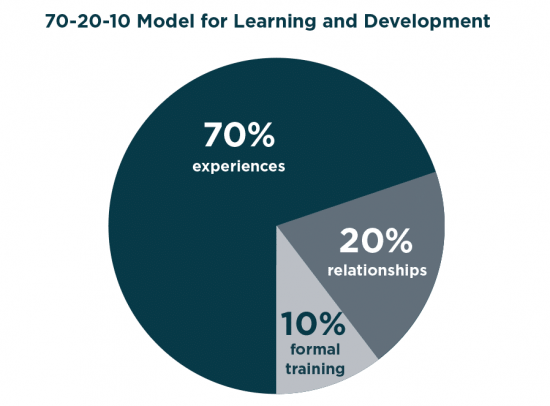
The model suggests that professional development is most effective when 70% of learning comes from experiences, 20% comes from relationships, and 10% comes from formal training. It is helpful to keep this model in mind when creating an executive talent development plan for your high-potential employees.
Provide Experiential Learning Opportunities
As the 70-20-10 Model suggests, 70% of an executive talent development plan should consist of experiential learning opportunities. Here are a handful of ways you can incorporate experiential learning into your talent development strategy:
- Task with a Challenge: Offering stretch assignments provides an excellent opportunity to develop leadership potential. Assign challenging projects to your high-potential employees that require them to demonstrate leadership not only over the task itself but also over themselves and others. By stretching their abilities, you provide room for growth and allow them to rise to the occasion.
- Create Crucible Experiences: Effective leadership entails navigating uncharted territory without constant guidance. Provide high-potential employees with opportunities for “crucible experiences”—situations that challenge them deeply and lead to transformative insights. These experiences act as pivotal moments where individuals emerge with altered perspectives on themselves and their capabilities.
- Emphasize Reflection: Encourage self-reflection as an integral part of the learning process. After each experiential learning opportunity, engage in a debriefing session with your employees to facilitate reflection. Encourage them to identify their successes and opportunities for growth. Through reflection, individuals gain valuable insights into their strengths and areas requiring improvement, fostering ongoing personal and professional growth.

Leveraging the Power of the Peer Rotation
While working as a leadership development facilitator at Boeing, C12 Principal Chair Greg Atchison highlighted that the company partnered with five companies to create a rotational program for business executives. Every quarter, three leaders from each company spent several days shadowing the C-suite of one of the other five companies before rotating to another. Today, all three of Boeing’s executives are holding C-suite positions. The success of this program highlights the power of leveraging peer insight to cross-train your high potentials. This practice can be adapted for companies of any size.
Prioritizing Relational Learning
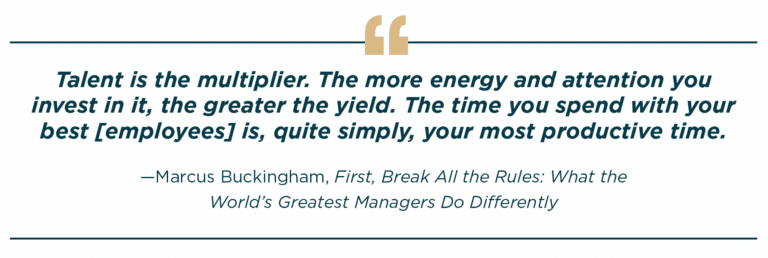
In addition to experiential learning, the 70-20-10 Model suggests that the next most important development experience comes through relationships. You can encourage relational learning by:
- Providing Exposure to the Next Level: Offer high potentials exposure to the next level by encouraging mentoring relationships, providing access to executive coaches, and inviting them to attend executive-level meetings. These relationships will offer emerging leaders a glimpse into potential career paths, helping them visualize their future within the company.
- Engaging in Peer Learning Experiences: Consider investing in peer learning experiences to facilitate growth in your high potentials through interactions with other up-and-coming professionals. For instance, C12 offers a Business Forum for high-potential leaders in senior management positions within C12 member companies (known as the Key Player Program). Businesses that enroll multiple members of their leadership team in C12 often experience enhanced vision alignment, strategic plan deployment, and business performance.
- Intentionally Leveraging the Supervisor Relationship: Establish a weekly rhythm for leadership development and near-term work-related check-ins. During these sessions, set leadership development goals and track progress. One helpful worksheet is C12’s Development Action Plan (DAP), which outlines specific growth goals and provides a method to track progress over 12 months. The DAP focuses on enhancing skills in areas such as business acumen, leadership, and personal development. Regular meetings with direct reports allow you to:
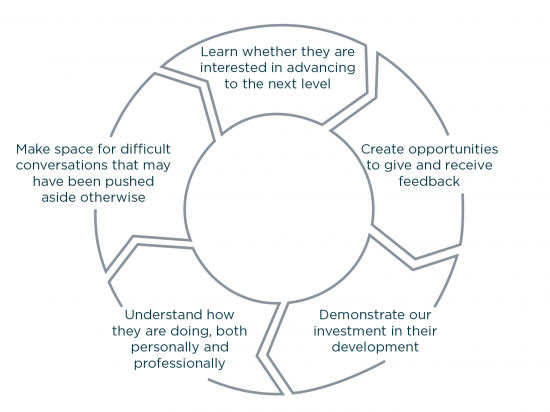
Download C12’s Development Action Plan (DAP) to create a comprehensive plan for enhancing your employees’ business acumen, leadership abilities, personal growth, skill set, and beyond.
Invest in Formal Training
While formal training constitutes just 10% of an optimal professional development blend, it is still an important aspect of executive talent development. Some competency gaps require a more structured learning environment. Companies invest in formal training for high-potential employees through various avenues:
- Sponsoring enrollment in leadership development courses
- Offering access to training to overcome skill deficiencies in areas such as financial literacy or operations management (e.g., Six Sigma or Entrepreneurial Operating System {EOS} training)
- Facilitating attendance at leadership development conferences such as the Global Leadership Summit or the World Business Forum
- Encouraging participation in leadership book discussions, either as a team or within a mentorship dynamic
- Granting access to skill-building sessions focused on emotional intelligence or conflict resolution
- Providing tuition reimbursement for pursuing advanced degrees such as an MBA or other graduate-level programs
Formal training can be conducted in traditional classroom settings or through online platforms. However, it is crucial not to overly rely on this approach alone, recognizing its limited share in the 70-20-10 Model.
Delegation: An Executive Talent Development Essential

Delegation involves entrusting others with greater authority to accomplish specific tasks. When delegating to an up-and-coming leader, you want to give them the autonomy to make decisions and take actions that influence the company’s performance while you, as their leader, retain ultimate responsibility. Through delegation, you:
- Empower your team members by fostering trust, ownership, and individual accountability throughout the organization
- Free yourself up to concentrate on critical strategic matters, business and organizational growth, and overall operational performance
Becoming comfortable with delegation often requires overcoming personal hesitations. However, the benefits are significant. Even if you have sufficient time to manage tasks independently, challenge yourself to delegate. Delegation communicates trust and appreciation to your employees. The rewards of delegation extend beyond task completion to cultivating team growth, enhancing productivity, and nurturing a culture of collaboration and empowerment.
Just as you learned to lead by leading, the individuals in your business will learn to lead only when you give them the opportunity to lead. Start by delegating small tasks that are easy to remove from your plate and stretch the current limits of the individual’s talent.
As you and your employee grow into your new roles, responsibilities, and tasks, the employee will become more confident in their leadership abilities, and delegation will become easier. As they progress, be sure not to simply delegate tasks but to delegate the authority to make real decisions with real consequences. By entrusting your high-potential employees with significant responsibilities, you facilitate their long-term development while also freeing yourself to accomplish the higher-level tasks that your organization needs from you. Everyone wins when leaders learn how to delegate effectively.
Talent Development: A Case Study
When Levi Smith joined Franklin Building Supply as CEO, his priority was to gain an understanding of what the company needed to be successful in the future. After conducting dozens of interviews with frontline workers, managers, and senior leadership, he became convinced about the need to effectuate cultural change. His strategy was anchored in equipping managers with the soft skills needed to help every individual at Franklin Building Supply reach their God-given potential.
Levi considers training and equipping managers to be a mission-critical task. Just five years later, Levi says the training has been “unbelievably transformative,” leading to Franklin Building Supply being recognized as one of Idaho’s Best Places to Work for four consecutive years. Watch this video to learn more about Levi’s journey and the transformative effects of manager training and development at Franklin Building Supply.
Bringing It All Together
When you take the time to develop executive talent, you will reap the rewards of a leadership pipeline that is ready to assume executive responsibilities. This process begins with identifying leadership potential, understanding competency gaps, and crafting a tailored plan to cultivate leadership abilities.
Tools such as the competency gap analysis and the Development Action Plan (DAP) can assist you in creating an executive talent development plan that delivers results. Adhere to the 70-20-10 Model by offering experiential learning opportunities, facilitating access to valuable relationships, and providing formal training as necessary. Remember to delegate authority, not just tasks, to empower growth and development.
Leaders who invest in executive talent development will establish a strong foundation for growth, ensuring a steady stream of capable individuals who are prepared to step into positions of leadership that your company will need to move confidently into the future.
C12 Business Forums provides an architected environment for Christian business leaders that integrates work, life, and leadership transformation. To learn more about C12’s approach to Christ-centered business leadership, find a C12 Business Forum near you.
February 27, 2024


